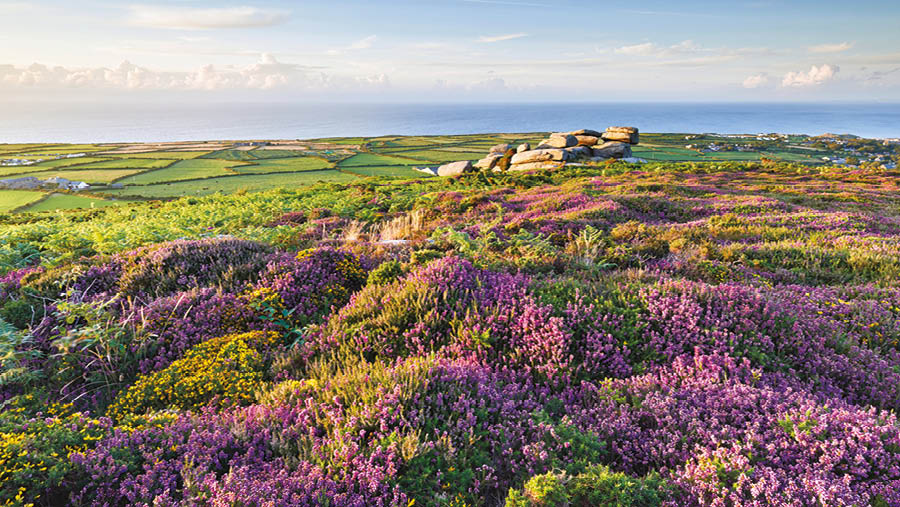Natural England’s protected landscapes plans risk farmers’ livelihoods
 Penwith Moors © Helen Dixon/Alamy Stock Photo
Penwith Moors © Helen Dixon/Alamy Stock Photo Natural England has revealed plans for more than 30 areas it wants to designate as “protected landscapes”, raising fears of additional costs, red tape and the possible closure of farming businesses.
Its designations programme includes 22 sites of special scientific interest (SSSIs), four areas of outstanding natural beauty (AONBs), and extensions to six national nature reserves (NNRs).
See also: Natural England ‘land grab’ threatens Cornish livelihoods
The UK government has a “30-by-30” target that aims to ensure 30% of land in England is covered by environmental protection by 2030 – and Natural England is under pressure to designate more farmland to help reach this goal.
However, some farmers are concerned that “prescriptions” attached to new SSSI designations, where productive land is included, will ultimately lead to the closure of their businesses without compensation.
Natural England has caused anger and upset among farmers and locals after designating 3,159ha in Penwith Moors, west Cornwall, to an SSSI.
Farmers and landowners within the proposed designation are furious that Natural England has imposed the plans on them without proper consultation or collaboration.
The project includes a set of 28 prescriptions that farmers say will severely limit their ability to maintain soil fertility and therefore their viability.
Restrictions
Rules include preventing farmers from applying lime to make pH adjustments to acidic soils, stopping the spreading of organic manures, drastically reducing livestock densities, and barring access to land with any vehicle, including a tractor.
One Cornish farmer, whose land is now inside an SSSI, said: “In its designations process, Natural England is beginning to step beyond the mark of its original remit and also include productive farmland.
“It has to in order to achieve the 30-by-30 target in seven years’ time.”
Farmers face further obstacles to planning applications as Natural England has become a statutory consultee in the planning process.
Planning restrictions are likely to apply to a 3km buffer zone outside the Penwith Moors SSSI.
There are currently 4,128 SSSIs (covering 1.1m ha) located across the country, including within protected landscapes, covering all priority habitats and many characteristic, rare and threatened species.
Farmers Weekly asked Natural England to detail how much additional land, including productive farmland, it plans to designate to new SSSIs, but it did not provide an answer.
‘Active management’
A spokesperson for the Country Land and Business Association said: “Designation alone has not delivered environmental improvement; active management is required.
“Designations must be based on up-to-date scientific evidence and come with a package of support for landowners to achieve long-term nature recovery.”
A Defra spokesperson said: “We are committed to protecting 30% of our landscapes by 2030, as part of our work to halt and reverse the decline in nature and meeting our domestic and international environment targets.
“Our farmers will have a key role in achieving this – with our Environmental Improvement Plan setting out how they can enhance our protected landscapes and the actions they can take, which has been backed up by a dedicated fund of more than £50m allowing them to deliver projects to achieve our 30-by-30 commitment.”
The harsh reality of SSSI plans for farmers
Cornish farmer Ian Flindall says Natural England’s decision to designate Penwith Moors as a site of special scientific interest (SSSI) is already causing farm businesses to fold.
Mr Flindall farms outdoor-reared pigs and beef on 46ha of land in St Just, west Cornwall.
Under the plans, just under 1ha of his land will be designated to a new SSSI, but the holding already has 10ha under an existing SSSI designation.
“As a statutory consultee in the planning process, Natural England is likely to compromise some sorts of development,” he says.
“For example, I was recently prevented from installing a small hydro-power system on a stream that has provided power to the tin mining industry for centuries.
“One could only imagine how they would react to an application for solar panels or a wind turbine in or near an SSSI. To my mind, these are equally important environmentally.”
Mr Flindall is very concerned Natural England is removing productive farmland without compensation or consultation with landowners, who would be only too pleased to work with the government on green schemes, such as Environmental Land Management.
